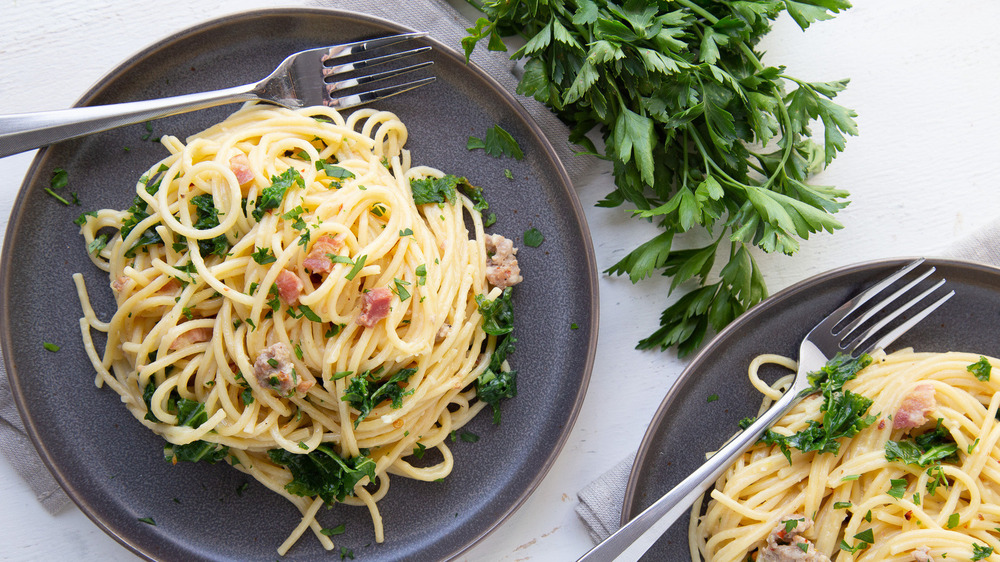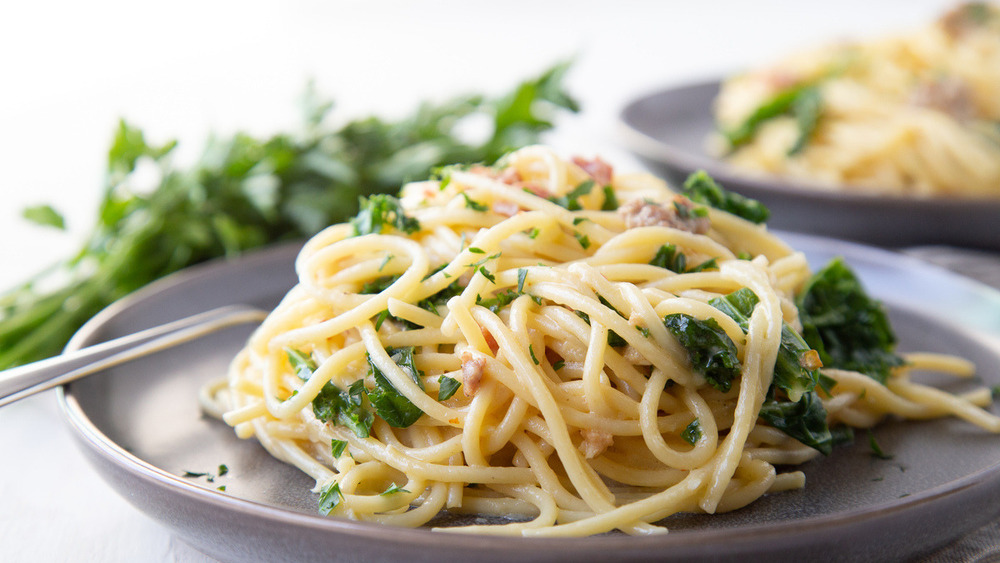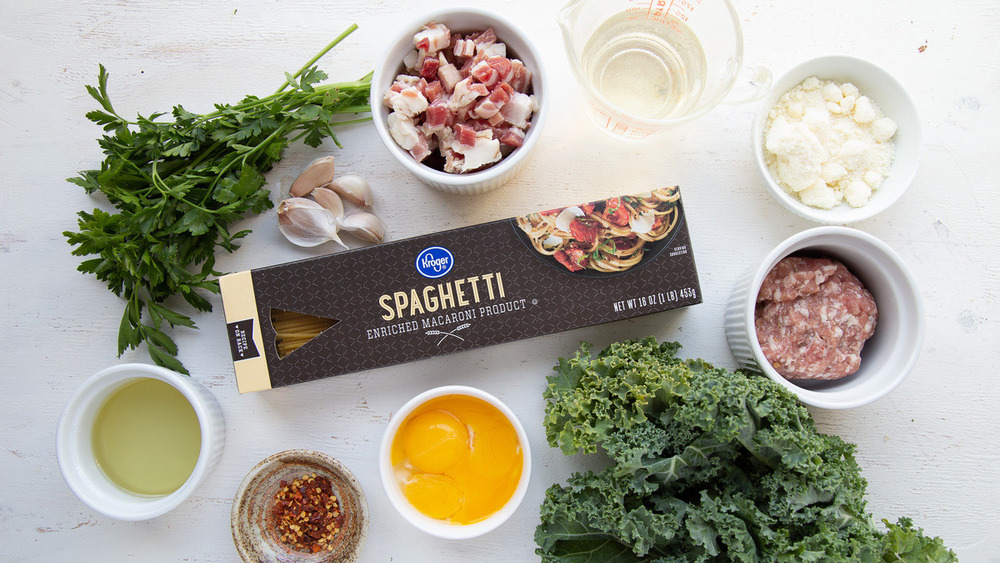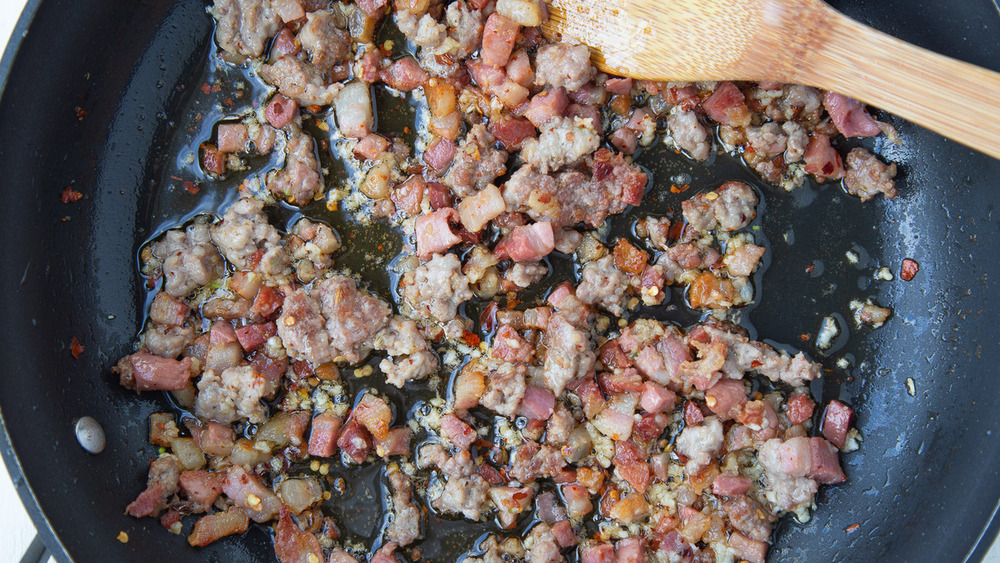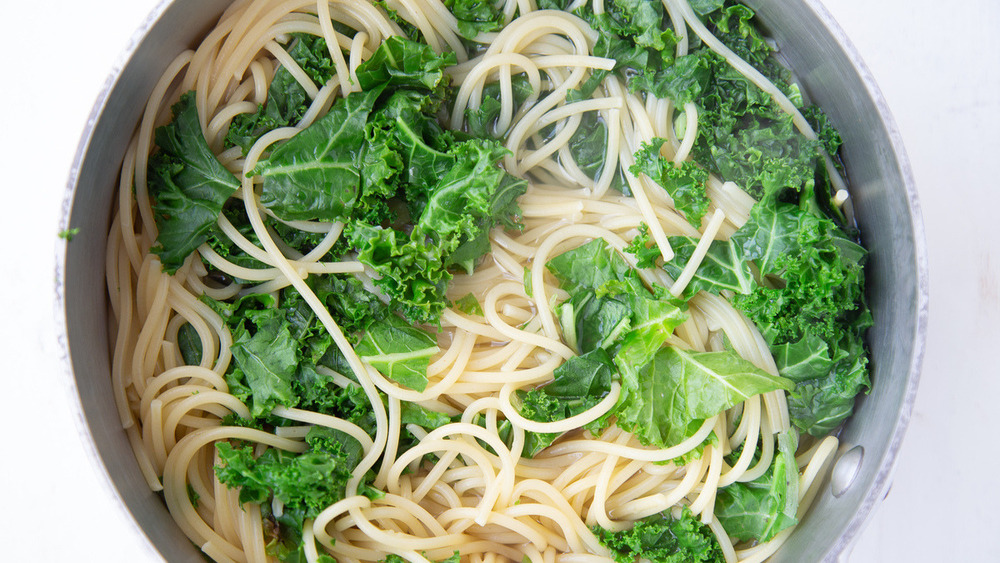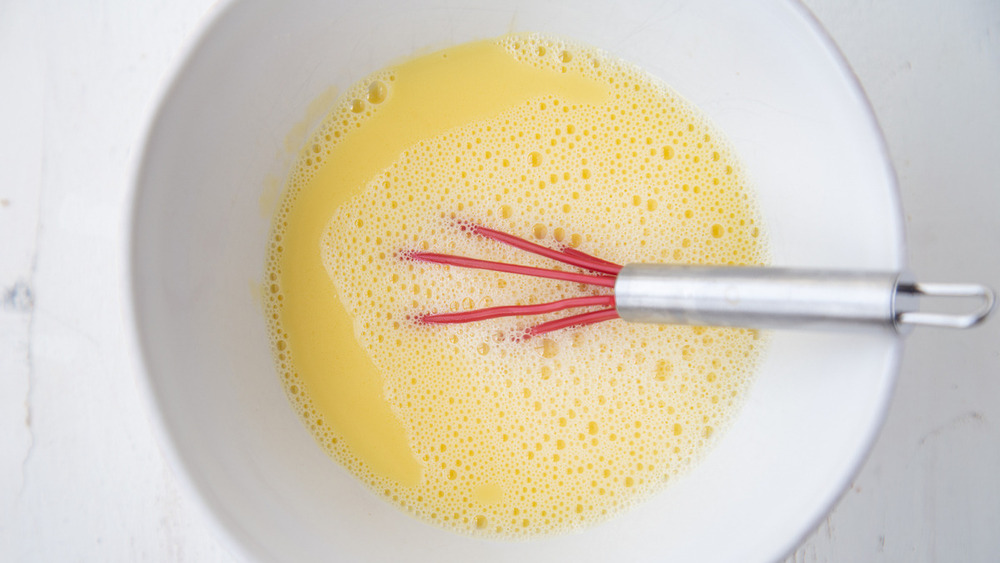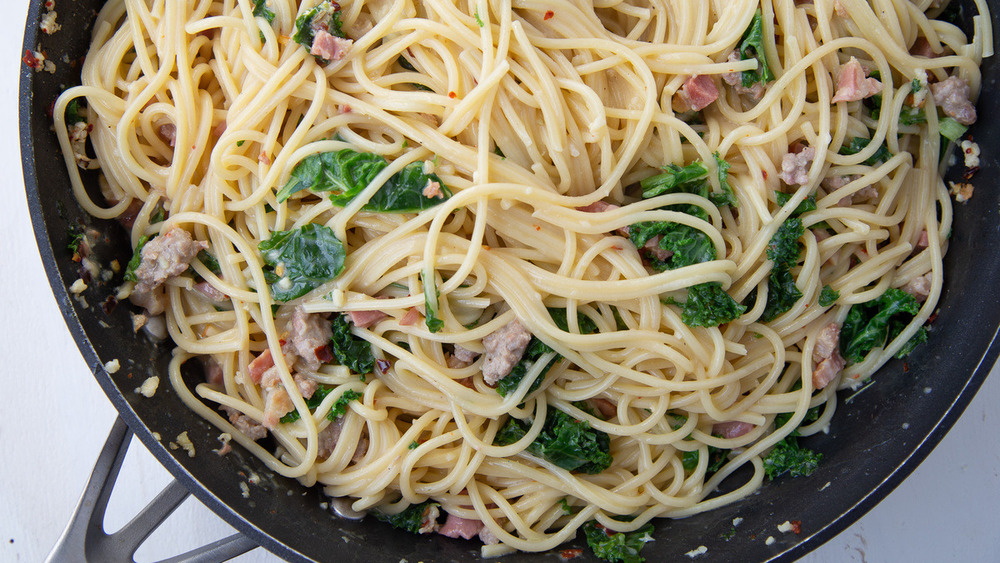Rachael Ray's Carbonara Recipe
Pasta carbonara hails from the Italian region of Lazio (Rome is this region's capital), where, legend has it, it was originally invented by coal miners (carbonai in Italian) who could easily stir the protein- and carb-rich dish of pasta and pancetta together in just one pot. Rachael Ray's version remains true to tradition, eschewing the erstwhile addition of cream to make the sauce, well, creamy. Instead, she relies on the thickening power of eggs, which are just barely cooked in the hot spaghetti so they coat each gorgeous strand. The resulting sauce is thick and rich, the perfect foil for salty pancetta. It's no wonder the coal miners of Lazio couldn't get enough of it — and with recipe developer Kate Shungu of The Gift of Hospitality as your guide, you too can master the techniques behind this easy, delicious recipe. Top it with parsley and cheese, and it's a dish fit for both coal miners and kings!
What did we change?
To turn this traditional primo piatto, or first course, into a complete meal all on its own, Shungu adds two extra ingredients to Ms. Ray's original recipe: ground Italian sausage and kale. The sausage gives it extra protein, keeping you fuller longer, and the kale lends added nutrients like vitamins A, K, and C. Together, they kick carbonara up a notch from just plain delicious to delicious and nutritious — the perfect weeknight dinner.
Gather the ingredients for the spaghetti carbonara
To make this dish, you will, of course, need pasta. Spaghetti is traditional, but Shungu notes that "any long, thin noodle works great in this recipe." Bucatini, fettuccine, or linguine could all be excellent substitutes, depending on your preference.
You'll also need pancetta, an Italian rolled bacon seasoned with herbs. If you can't find it, American bacon works as a substitute; it will just impart a slight smokiness to the dish that pancetta wouldn't. Red pepper flakes and garlic season the sauce, which also calls for a bit of dry white wine (use one you would be happy drinking) and, of course egg yolks, which create that creamy sauce.
Romano cheese is a hard, sheep's milk cheese hailing from the region around Rome and is the most traditional topping. If you want something with a bit less funk, however, you can easily opt for nutty Parmesan instead. "Look for Parmigiano Reggiano in the cheese section of your local grocery store," suggests Shungu, if you go that route. "Its flavor is far superior to the Parmesan cheese in the green can!"
Cook the pasta and the pork for the spaghetti carbonara
The sauce for the spaghetti carbonara comes together quickly, so the first thing you'll want to do is bring a large pot of water to a boil, season with salt, and add the pasta. While that's cooking, heat a large skillet and add the pancetta and sausage, cooking about four minutes. Season with the red pepper flakes and garlic, and cook until just heated and aromatic — about 30 seconds. Take care not to burn it!
Add the white wine, which will help you bring up any fond that has formed on the bottom of the pan: these cooked drippings will add lovely flavor to the finished sauce.
Add the kale to the pasta for the spaghetti carbonara
When the pasta is nearly cooked — about a minute out — add the chopped kale to the pot, which will help it wilt before stirring it into the sauce.
"You could add the fresh kale to the sausage, but you'll be stirring it for a while trying to get it to wilt down," says Shungu. "I like adding it to the pasta so it cooks with almost no hands-on time."
Temper the eggs for the spaghetti carbonara
The only slightly technical part of this recipe is tempering the eggs, which will keep them from scrambling and turning your spaghetti carbonara into a spaghetti omelet. To do this, whisk the egg yolks in a small bowl, and then drizzle in 1/2 cup of the pasta water, whisking quickly all the while.
"This step warms up the eggs (especially if they're cold from the refrigerator), bringing them closer to the temperature of the pasta," explains Shungu.
After fifteen seconds of constant whisking, they're ready to use.
Combine the pasta, sausage, and eggs for the spaghetti carbonara
The eggs are tempered; the pasta, sausage, and kale are cooked. It's time to combine everything! To do so, first drain the pasta and kale, and then add them directly to the skillet with the sausage and pancetta, set over low heat. Next, pour the tempered egg mixture over the top, tossing gently with tongs for a minute or two, or until the sauce is thick and coats the spaghetti.
Stir in a large handful of cheese, and it's time to plate and dig in!
Rachael Ray's carbonara with a twist
We've taken Rachael Ray's pasta carbonara recipe and tweaked it with some kale and Italian sausage to make a one-dish wonder you'll want to eat every night.
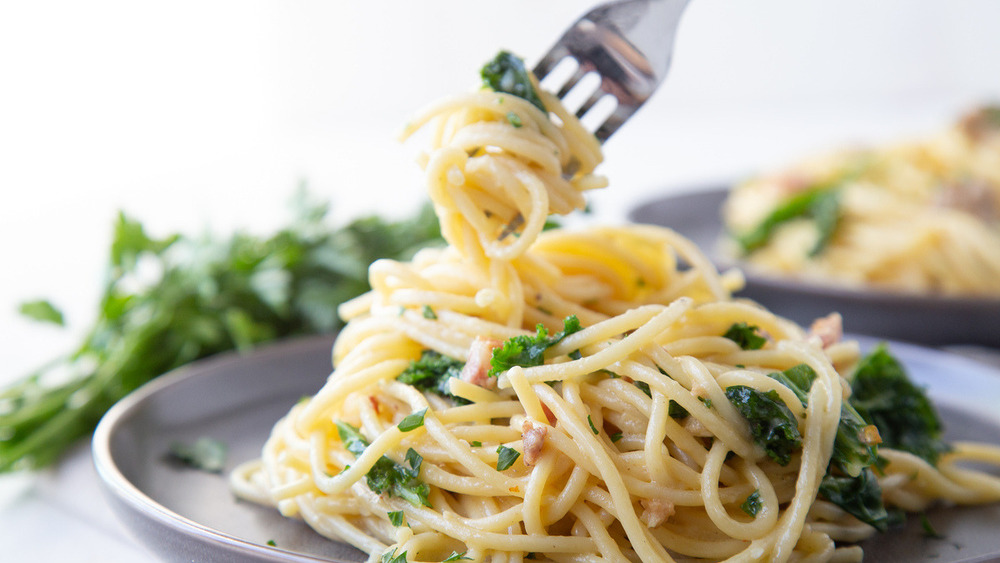
Ingredients
- 1 pound spaghetti (or any kind of long, thin noodle)
- 1 small bunch fresh kale, chopped
- 2 tablespoons extra-virgin olive oil
- ¼ pound pancetta (Italian bacon), chopped
- ½ pound ground Italian sausage
- 1 teaspoon red pepper flakes
- 5–6 cloves garlic, chopped
- ½ cup dry white wine
- 3 large egg yolks
- Salt and freshly ground black pepper, to taste
- Freshly grated Romano cheese
- A handful of finely chopped flat-leaf parsley, to garnish
Directions
- Bring a large pot of water to a boil. Salt the water and add the pasta. Cook according to package directions. During the last minute of cooking time, add the kale.
- While the pasta is cooking, place the olive oil in a large skillet over medium heat. Add the pancetta and Italian sausage. Cook, stirring occasionally, until the sausage is cooked through, about 4 minutes.
- Add the red pepper flakes and garlic, and cook for 30 seconds more. Stir in the white wine, scraping the bottom of the pan to loosen any drippings.
- Place the egg yolks in a small bowl. Add ½ cup of the pasta water, and whisk quickly to combine. This step tempers the eggs to prevent them from scrambling when they are added to the pasta.
- Drain the pasta and kale, and transfer them into the skillet with the sausage and pancetta. Pour the egg yolk mixture over the top, and toss the pasta gently with tongs for 1–2 minutes, or until the egg mixture thickens.
- Stir in a large handful of Romano cheese. Place the pasta onto plates and garnish with fresh chopped parsley and extra Romano cheese.
Nutrition
| Calories per Serving | 592 |
| Total Fat | 27.5 g |
| Saturated Fat | 8.5 g |
| Trans Fat | 0.0 g |
| Cholesterol | 133.4 mg |
| Total Carbohydrates | 61.4 g |
| Dietary Fiber | 3.6 g |
| Total Sugars | 3.1 g |
| Sodium | 452.8 mg |
| Protein | 20.4 g |
